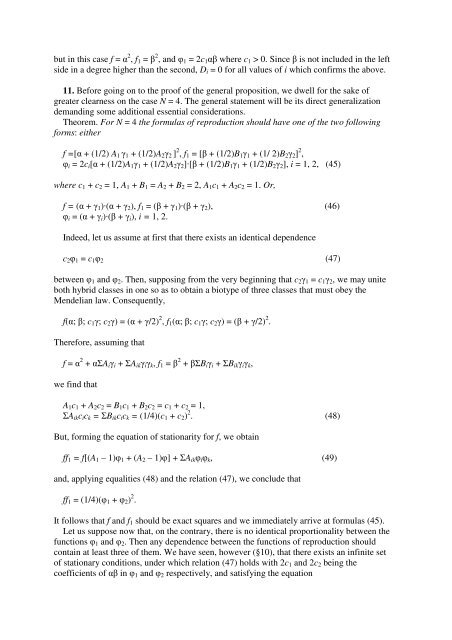kniga 7 - Probability and Statistics 1 - Sheynin, Oscar
kniga 7 - Probability and Statistics 1 - Sheynin, Oscar
kniga 7 - Probability and Statistics 1 - Sheynin, Oscar
Create successful ePaper yourself
Turn your PDF publications into a flip-book with our unique Google optimized e-Paper software.
ut in this case f = 2 , f 1 = 2 , <strong>and</strong> 1 = 2c 1 where c 1 > 0. Since is not included in the leftside in a degree higher than the second, D i = 0 for all values of i which confirms the above.11. Before going on to the proof of the general proposition, we dwell for the sake ofgreater clearness on the case N = 4. The general statement will be its direct generalizationdem<strong>and</strong>ing some additional essential considerations.Theorem. For N = 4 the formulas of reproduction should have one of the two followingforms: eitherf =[ + (1/2) A 1 1 + (1/2)A 2 2 ] 2 , f 1 = [ + (1/2)B 1 1 + (1/ 2)B 2 2 ] 2 , i = 2c i [ + (1/2)A 1 1 + (1/2)A 2 2 ][ + (1/2)B 1 1 + (1/2)B 2 2 ], i = 1, 2, (45)where c 1 + c 2 = 1, A 1 + B 1 = A 2 + B 2 = 2, A 1 c 1 + A 2 c 2 = 1. Or,f = ( + 1 )( + 2 ), f 1 = ( + 1 )( + 2 ), (46) i = ( + i )( + i ), i = 1, 2.Indeed, let us assume at first that there exists an identical dependencec 2 1 = c 1 2 (47)between 1 <strong>and</strong> 2 . Then, supposing from the very beginning that c 2 1 = c 1 2 , we may uniteboth hybrid classes in one so as to obtain a biotype of three classes that must obey theMendelian law. Consequently,f(; ; c 1 ; c 2 ) = ( + /2) 2 , f 1 (; ; c 1 ; c 2 ) = ( + /2) 2 .Therefore, assuming thatf = 2 + A i i + A ik i k , f 1 = 2 + B i i + B ik i k ,we find thatA 1 c 1 + A 2 c 2 = B 1 c 1 + B 2 c 2 = c 1 + c 2 = 1,A ik c i c k = B ik c i c k = (1/4)(c 1 + c 2 ) 2 . (48)But, forming the equation of stationarity for f, we obtainff 1 = f[(A 1 – 1) 1 + (A 2 – 1)] + A ik i k , (49)<strong>and</strong>, applying equalities (48) <strong>and</strong> the relation (47), we conclude thatff 1 = (1/4)( 1 + 2 ) 2 .It follows that f <strong>and</strong> f 1 should be exact squares <strong>and</strong> we immediately arrive at formulas (45).Let us suppose now that, on the contrary, there is no identical proportionality between thefunctions 1 <strong>and</strong> 2 . Then any dependence between the functions of reproduction shouldcontain at least three of them. We have seen, however (§10), that there exists an infinite setof stationary conditions, under which relation (47) holds with 2c 1 <strong>and</strong> 2c 2 being thecoefficients of in 1 <strong>and</strong> 2 respectively, <strong>and</strong> satisfying the equation









